

Wired 9.02: Forging the Dragonslayer. Forging the Dragonslayer QuesTek's superstrong cyber-alloy promises to reinvent steel.
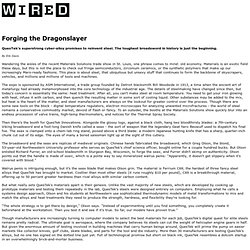
The toughest broadsword in history is just the beginning. By Erik Davis Wandering the aisles of the recent Materials Solutions trade show in St. Louis, one phrase comes to mind: old economy. The expo is sponsored by ASM International, a trade group founded by Detroit blacksmith Bill Woodside in 1913, a time when the ancient art of metallurgy had already metamorphosed into the core technology of the industrial age.
Then there's the booth for QuesTek Innovations. The broadsword and the seax are replicas of medieval originals. Walrus penis is intriguing enough, but it's the seax blade that makes Olson grin. But what really sets QuesTek's materials apart is their genesis. "The whole strategy is to get there by design," Olson says. Though manufacturers are increasingly turning to computer models to select the best materials for each job, QuesTek's digital quest for elite steels remains pretty radical. Seax. The remains of a seax together with a reconstructed replica Seax (also sax, sæx, sex, latinized sachsum) is an Old English word for "knife".[1] In modern archaeology, the term seax is used specifically for a type of sword or dagger typical of the Germanic peoples of the Migration period and the Early Middle Ages, especially the Saxons, whose tribal name derives from the weapon.[2] Old English seax, sax and Old Frisian sax are identical with Old Saxon and Old High German saks, all from a Common Germanic *sahsom from a root *sah, *sag- "to cut" (also in saw, from a PIE root *sek-).
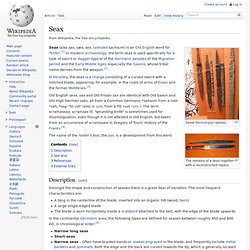
The term scramaseax, scramsax lit. "wounding-knife" is sometimes used for disambiguation, even though it is not attested in Old English, but taken from an occurrence of scramasaxi in Gregory of Tours' History of the Franks.[4] Description[edit] Katana. Historically, katana (刀?)
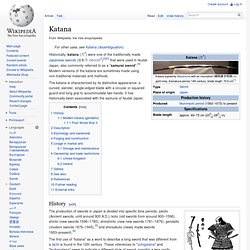
Were one of the traditionally made Japanese swords (日本刀, nihontō?) [2][3] that were used in feudal Japan, also commonly referred to as a "samurai sword".[4] Modern versions of the katana are sometimes made using non-traditional materials and methods. The katana is characterized by its distinctive appearance: a curved, slender, single-edged blade with a circular or squared guard and long grip to accommodate two hands. It has historically been associated with the samurai of feudal Japan. History[edit] The World's Strongest Stuff. By Melissa Salpietra Posted 11.24.10 NOVA Ask a materials scientist to choose the strongest material, and you are likely to get a question instead of an answer.
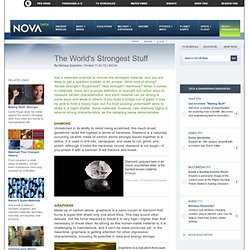
What kind of strong? Tensile strength? Toughness? Yield strength? Maraging, Maraging Steel - All Metals & Forge. Maraging 250 Maraging 300 Maraging 350 Maraging 362 Maraging Steel Maraging 250 Maraging 250 is an 18 percent nickel steel that has been strengthened with cobalt.

Maraging 250, like all maraging steels, goes through an aging process that forces the metal to cool from its molten state to its solid state over an artificially long time. This process results in a tempered steel that has both high levels of strength and hardness. It will also resist certain stresses and maintain its structure in environments that would cause irreparable changes to many other steels. The properties that make Maraging 250 particularly appealing to many industries is its workability. After Maraging 250 has undergone heat treatment, it demonstrates excellent mechanical properties. Spectra Fiber. Spectra® fiber is one of the strongest and lighest fibers available.

A bright white polyethylene, it is 15 times stronger than steel, more durable than polyester and has a specific strength that is 40% greater than aramid fiber. With outstanding toughness and extraordinary visco-elastic properties, Spectra fiber can withstand high load strain rate velocities. Properties of Spectra® Fiber: One of the highest strength to weight ratios of any manmade fiberOustanding toughness and visco-elasti propertiesLight enough to floatHigh resistance to chemicals, water and ultraviolet lightExcellent vibration damping, flex fatigue and internal fiber friction characteristicsLow elongationHigh resistance to abrasionResists corrosionLow dielectric constant Applications:
Amorphous metal. Samples of amorphous metal, with millimeter scale In the past, small batches of amorphous metals have been produced through a variety of quick-cooling methods.
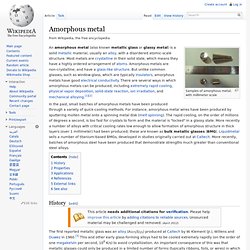
For instance, amorphous metal wires have been produced by sputtering molten metal onto a spinning metal disk (melt spinning). The rapid cooling, on the order of millions of degrees a second, is too fast for crystals to form and the material is "locked" in a glassy state. More recently a number of alloys with critical cooling rates low enough to allow formation of amorphous structure in thick layers (over 1 millimeter) had been produced; these are known as bulk metallic glasses (BMG). Liquidmetal sells a number of titanium-based BMGs, developed in studies originally carried out at Caltech.
History[edit] The first reported metallic glass was an alloy (Au75Si25) produced at Caltech by W. In 1969, an alloy of 77.5% palladium, 6% copper, and 16.5% silicon was found to have critical cooling rate between 100 to 1000 K/s. Properties[edit] Ferriumc69. 10 Futuristic Materials. Lifeboat Foundation Safeguarding Humanity Skip to content Switch to White Special Report 10 Futuristic Materials by Lifeboat Foundation Scientific Advisory Board member Michael Anissimov. 1.
